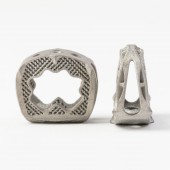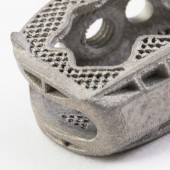SureMAX Cervical Implant by Additive Implants Inc. |
Home > Winners > #88502 |
 |
|
||||
| DESIGN DETAILS | |||||
| DESIGN NAME: SureMAX PRIMARY FUNCTION: Cervical Implant INSPIRATION: The inspiration was the lack of a solution that took advantage of new geometries that can be created with Titanium which is the best material for bone to grow into by a spine surgeon who performs over 300 cervical surgeries a year. He wanted an implant made from Titanium that matched bone's hardness, not to damage the vertebra, was visible in X-rays, so healing could be seen through, and would not subside in the spine. UNIQUE PROPERTIES / PROJECT DESCRIPTION: SureMAX is the first Titanium spinal implant that has a stiffness that matches the individual's bone stiffness as not to damage it. Bone loves to grow into Titanium but Titanium cages have been limited because they are too stiff and damage the bone. SureMAX has solved this problem through using 3D print technology with geometries that are not machinable. It also has a porous roughen surface to encourage bone to grow into it. OPERATION / FLOW / INTERACTION: The implant is used in an Anterior Cervical Discectomy Fusion (ACDF) surgery where the front of the neck is opened, the damaged cartilage removed and an implant is inserted in order to fuse the vertebra. The implant comes in a sterile plastic package. The surgeon once the damage is observed and removed assesses the size required. The appropriate implant size, angle and foot print is selected and inserted into the spine. A plate is then used (not part of SureMAX) to attach the upper and lower vertebra. The bone then grows into the implant (called inter body fusion device IBFD) and the patient heals. PROJECT DURATION AND LOCATION: The design started in 2015 and ended in October 2018 and FDA approval was received in February 2019 (3 year design and 4 month approval). The work was done in Phoenix Arizona USA. FITS BEST INTO CATEGORY: Medical Devices and Medical Equipment Design |
PRODUCTION / REALIZATION TECHNOLOGY: 3D print technology has been used with Titanium powder (Ti6Al4) using porous surface technology to achieve designs that will encourage bone to grow into the spinal implant SPECIFICATIONS / TECHNICAL PROPERTIES: There are 72 sizes for SureMAX. The height, the foot print and the angle of the implant are the 3 choices. The angles are 0, 7 and 14 degrees. The choice of the angle is used to correct any stenosis in the spine (this is when the spine has a deformity and the implant is used to fix it). The heights are 5,6,7,8,9,10,11 and 12 mm. The foot prints are 12x14 mm, 14x16 mm and 15x118mm. All units come in a sterile plastic package. TAGS: spinal implant, Inter body fusion device, IBFD, cage, Titanium, Ti Cage, 3D printed, Spine RESEARCH ABSTRACT: Titanium (Ti) has always been the material of choice for implants. But Ti is hard to machine and is very stiff. In the interface between Ti and bone, bone can be damaged and the implant subside ( or settle ) in the body. Plastic and Allograft bone material implants are used to address Ti's limitations. Additional, Ti is not X-ray translucent, so physicians can not see how the bone heals through and around the implant. Plastic implants also have the limitation that they remain inert in the body- they are never adsorbed. Bone however grows very well into Ti. The challenge was to create a Ti spinal cervical implant (cervical is for the neck) that had the same stiffness as bone as not to damage it, would not subside (it would stay on top of the bone and not settle), would remain in the position inserted (with the neck movement would not slip), X-ray could go through it (healing could be observed), would pass the stress test required by the FDA and would be cost effective. CHALLENGE: To get result required- a high performance implants which is cost competitive, the team had to design a part that could both hand the stresses and forces required by the US government FDA while solving the patient challenges. The part had to be designed so minimal post processing would be required after 3D printing. Additionally, the rough porous surface which helps the healing process required advance software and new methodologies to manufacture. The diving boards had to share the spinal loads equally in order not to displace the implant in the spine. Side windows had to be designed that permits the loads to be distributed and have large have enough surface to see the bone healing. The hardest part of the design activity was to figure out how 8 independent platforms on both sides of the implant could function as a single unit and share the loads appropriately. The surface had to be porous and roughened Ti that could handle the appropriate loads. The teeth had to be the correct size and angle in order to assure stability, but not too big or small to them a ineffective. ADDED DATE: 2019-06-27 16:54:59 TEAM MEMBERS (6) : Dr. John Ehteshami MD, Robert Brosnehan, Matt Zoghi, JD Howell, Jeff Horn and Babak Ehteshami IMAGE CREDITS: Additive Implants Inc., 2019. PATENTS/COPYRIGHTS: Patented #10,299,938 Additive Implants Inc., May 2019, USA 5 additional patent pending and provisional patents FDA #K182477 (2019), holder Additive Implants Inc. USA Trademark #88115736 (2018), Additive Implants Inc. USA |
||||
| Visit the following page to learn more: http://additiveimplants.com | |||||
| AWARD DETAILS | |
 |
Suremax Cervical Implant by Additive Implants Inc is Winner in Medical Devices and Medical Equipment Design Category, 2019 - 2020.· Read the interview with designer Additive Implants Inc. for design SureMAX here.· Press Members: Login or Register to request an exclusive interview with Additive Implants Inc.. · Click here to register inorder to view the profile and other works by Additive Implants Inc.. |
| SOCIAL |
| + Add to Likes / Favorites | Send to My Email | Comment | Testimonials | View Press-Release | Press Kit |
Did you like Additive Implants Inc's Medical Product Design?
You will most likely enjoy other award winning medical product design as well.
Click here to view more Award Winning Medical Product Design.







